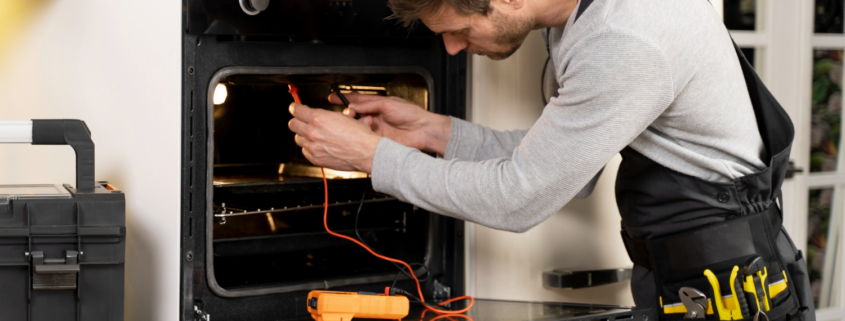How to Test and Tag Your Electrical Appliances at Home
Ensuring that your electrical appliances are safe to use is crucial for any household. Electrical faults can cause serious accidents, including fires and electric shocks. One effective way to make sure your appliances are safe is to test and tag them regularly. This process checks that your appliances are working correctly and highlights any potential issues.
Testing and tagging might sound complicated, but it can be straightforward with the right guidance. Don’t worry; we’ll explain how to test and tag your electrical appliances at home. You’ll learn why it’s important, what tools you’ll need, and the steps to follow.
Whether you have experience with electrical work or are a complete beginner, we’ll provide you with the information you need to get started. Let’s dive into how to test and tag your electrical appliances effectively and efficiently.
What is Test and Tag?
Test and tag is a process to ensure electrical appliances are safe to use. It involves two steps: testing the appliance with specialised equipment to check its safety and functionality, and then tagging it with a label to show it has been tested.
The tag usually includes the date of the test, the name of the person who performed it, and the next due test date. This process helps prevent electrical accidents by identifying faulty or unsafe devices.
Legal and Safety Reasons for Testing and Tagging
Legally, many workplaces are required to perform test and tag procedures regularly to comply with safety regulations. However, testing and tagging at home is equally important for safety reasons.
Regularly testing your appliances can help identify potential hazards before they cause harm. Electrical faults can lead to fires, electric shocks, or even fatal accidents. Following a test and tag routine helps protect your family and property from these dangers.
Benefits of Regular Appliance Testing
Regular appliance testing comes with several benefits. It extends the lifespan of your devices by catching issues early, preventing them from developing into bigger problems. It also ensures that your appliances operate efficiently, which can save on energy costs. Plus, a simple test can provide peace of mind, knowing that your home is safe from electrical hazards. When appliances are regularly tested and tagged, you lessen the risk of unexpected breakdowns and costly repairs.
Tools and Materials Needed for Testing and Tagging
Before starting the testing and tagging process, gather all necessary tools and equipment. Here’s what you’ll need:
- Portable appliance tester
- Insulation resistance tester
- Digital Multimeter
- Tags or labels for marking tested appliances
- Permanent marker
- Logbook or digital record-keeping tool
Safety Gear and Precautions
Safety is the top priority when working with electrical appliances. Make sure to use appropriate safety gear:
- Insulated gloves to protect against electric shocks
- Safety goggles to shield your eyes from sparks or debris
- Non-conductive footwear to minimise the risk of grounding
- A fire extinguisher nearby, just in case
Always follow safety procedures, such as turning off and unplugging appliances before testing and keeping water away from testing areas.
Where to Obtain a Portable Appliance Tester
You can purchase portable appliance testers from various places. Local hardware stores often carry them, and they can be found online through specialised electrical supply retailers. Look for a model that suits your needs and budget.
Some units come with additional features, like built-in printers for tags, which can save time. Ensure the tester you select complies with current safety standards to guarantee accurate and reliable results.
Gathering the right tools and safety gear is essential to performing effective and safe testing and tagging of your electrical appliances. Being well-prepared sets the foundation for a smooth and efficient process.
Pre-Testing Preparations: Inspecting the Appliance
Before you begin testing, inspect each appliance for visible signs of damage. Look for frayed cords, cracked plugs, or any other issues that might pose a safety threat. Make sure the appliance is unplugged. If you notice any problems, consider repairing the appliance first or replacing it if necessary.
Using a Portable Appliance Tester: How-To Instructions
- Plug the appliance into the portable appliance tester.
- Select the right test settings on the tester based on the manufacturer’s instructions.
- Turn on the appliance and follow the prompts on the tester to conduct the tests, which usually include earth continuity, insulation resistance, and polarity tests.
- Record the results for each test. If the appliance fails any test, it should be taken out of service immediately.
Interpreting Results: What the Readings Mean
The readings on your portable appliance tester will inform you whether an appliance is safe to use. A pass means all tests were successful:
- Earth continuity should show low resistance.
- Insulation resistance should be high, indicating no current leakage.
- Polarity tests should confirm correct wiring.
If any of these results are problematic, the appliance isn’t safe for use. You may need to repair it or replace it.
Tagging Your Appliance: How to Label Correctly
After testing an appliance, it must be tagged correctly. Use a permanent marker to fill out the tag with the testing date, the next test date, your initials, and the test results. Attach the tag to the appliance in a visible location. This way, anyone who uses the appliance will know it has been tested and is safe to use.
How Often to Test and Tag Appliances
The frequency of testing and tagging depends on the type of appliance and its usage. Appliances used frequently in high-risk environments, like kitchens or workshops, should be tested more often. Generally, a yearly test is a good rule of thumb for most home appliances. Check the guidelines for specific appliances to ensure compliance with safety standards.
Keeping a Testing Log: Importance and Tips
Maintaining a log of your testing and tagging efforts is crucial. Use a notebook or digital tool to record each appliance’s test date, next test due date, and results. Regularly update this log to ensure no appliance is missed. This habit helps keep your home safe and maintains an organised record in case of any issues.
Achieve Electrical Safety with Home Testing
Testing and tagging your electrical appliances at home is a vital task to ensure safety and prevent accidents. By understanding its importance, gathering the right tools, and following a clear step-by-step guide, you can effectively test and tag your appliances. Keeping regular records and knowing when to seek professional help can further enhance the safety of your home.
Staying proactive about appliance safety protects your family and keeps your household running smoothly. If you need expert assistance or have complex electrical issues, don’t hesitate to contact Thomas Blake Electrical to ensure your home stays safe and efficient.
Keep your home safe by testing and tagging your appliances regularly. If you need professional help, our team of electricians in Brisbane is here to help you with all your electrical needs!



